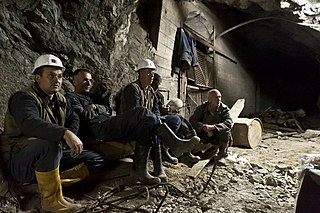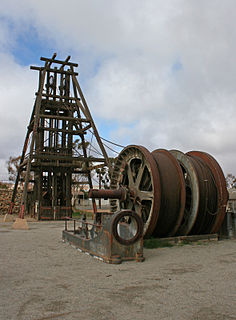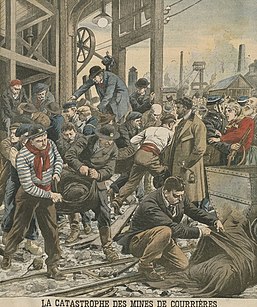Related Research Articles

Mining is the extraction of valuable minerals or other geological materials from the Earth, usually from an ore body, lode, vein, seam, reef, or placer deposit. Exploitation of these deposits for raw material is based on the economic viability of investing in the equipment, labor, and energy required to extract, refine and transport the materials found at the mine to manufacturers who can use the material.

Petroleum engineering is a field of engineering concerned with the activities related to the production of Hydrocarbons, which can be either crude oil or natural gas. Exploration and production are deemed to fall within the upstream sector of the oil and gas industry. Exploration, by earth scientists, and petroleum engineering are the oil and gas industry's two main subsurface disciplines, which focus on maximizing economic recovery of hydrocarbons from subsurface reservoirs. Petroleum geology and geophysics focus on provision of a static description of the hydrocarbon reservoir rock, while petroleum engineering focuses on estimation of the recoverable volume of this resource using a detailed understanding of the physical behavior of oil, water and gas within porous rock at very high pressure.

Underground hard-rock mining refers to various underground mining techniques used to excavate "hard" minerals, usually those containing metals, such as ore containing gold, silver, iron, copper, zinc, nickel, tin, and lead. It also involves the same techniques used to excavate ores of gems, such as diamonds and rubies. Soft-rock mining refers to the excavation of softer minerals, such as salt, coal, and oil sands.

Coal mining is the process of extracting coal from the ground. Coal is valued for its energy content and since the 1880s has been widely used to generate electricity. Steel and cement industries use coal as a fuel for extraction of iron from iron ore and for cement production. In the United Kingdom and South Africa, a coal mine and its structures are a colliery, a coal mine is called a 'pit', and the above-ground structures are a 'pit head'. In Australia, "colliery" generally refers to an underground coal mine.

A miner is a person who extracts ore, coal, chalk, clay, or other minerals from the earth through mining. There are two senses in which the term is used. In its narrowest sense, a miner is someone who works at the rock face; cutting, blasting, or otherwise working and removing the rock. In a broader sense, a "miner" is anyone working within a mine, not just a worker at the rock face.

Mining in the engineering discipline is the extraction of minerals from underneath, open pit, above or on the ground. Mining engineering is associated with many other disciplines, such as mineral processing, exploration, excavation, geology, and metallurgy, geotechnical engineering and surveying. A mining engineer may manage any phase of mining operations, from exploration and discovery of the mineral resources, through feasibility study, mine design, development of plans, production and operations to mine closure.

Gold mining is the extraction of gold resources by mining. Historically, mining gold from alluvial deposits used manual separation processes, such as gold panning. However, with the expansion of gold mining to ores that are not on the surface, has led to more complex extraction processes such as pit mining and gold cyanidation. In the 20th and 21st centuries, most volume of mining was done by large corporations, however the value of gold has led to millions of small, artisanal miners in many parts of the Global South.

Shaft mining or shaft sinking is the action of excavating a mine shaft from the top down, where there is initially no access to the bottom. Shallow shafts, typically sunk for civil engineering projects, differ greatly in execution method from deep shafts, typically sunk for mining projects.

A hoist is a device used for lifting or lowering a load by means of a drum or lift-wheel around which rope or chain wraps. It may be manually operated, electrically or pneumatically driven and may use chain, fiber or wire rope as its lifting medium. The most familiar form is an elevator, the car of which is raised and lowered by a hoist mechanism. Most hoists couple to their loads using a lifting hook. Today, there are a few governing bodies for the North American overhead hoist industry which include the Hoist Manufactures Institute, ASME, and the Occupational Safety and Health Administration. HMI is a product counsel of the Material Handling Industry of America consisting of hoist manufacturers promoting safe use of their products.

Exploration diamond drilling is used in the mining industry to probe the contents of known ore deposits and potential sites. By withdrawing a small diameter core of rock from the orebody, geologists can analyse the core by chemical assay and conduct petrologic, structural, and mineralogical studies of the rock.

A headframe is the structural frame above an underground mine shaft so as to enable the hoisting of machinery, personnel, or materials.

A drifter drill, sometimes called a rock drill, is a tool used in mining and civil engineering to drill into rock. Rock drills are used for making holes for placing dynamite or other explosives in rock blasting, and holes for plug and feather quarrying.

Stantec Inc. is an international professional services company in the design and consulting industry. Founded in 1954, as D. R. Stanley Associates in Edmonton, Alberta. Stantec provides professional consulting services in planning, engineering, architecture, interior design, landscape architecture, surveying, environmental sciences, project management, and project economics for infrastructure and facilities projects. The Company provides services on projects around the world through over 25,000 employees operating out of more than 400 locations in North America and across offices in 6 continents internationally.
A mining feasibility study is an evaluation of a proposed mining project to determine whether the mineral resource can be mined economically. There are three types of feasibility study used in mining, order of magnitude, preliminary feasibility and detailed feasibility.

Underground mine ventilation provides a flow of air to the underground workings of a mine of sufficient volume to dilute and remove dust and noxious gases (typically NOx, SO2, methane, CO2 and CO) and to regulate temperature. The source of these gases are equipment that runs on diesel engines, blasting with explosives, and the orebody itself. The largest component of the operating cost for mine ventilation is electricity to power the ventilation fans, which may account for one third of a typical underground mine's entire electrical power cost.
Jack de la Vergne is a Canadian civil engineer who specializes in underground mining and recipient of the Professional Engineers Ontario Engineering Medal in 2005.

In underground mining a hoist or winder is used to raise and lower conveyances within the mine shaft. Modern hoists are normally powered using electric motors, historically with direct current drives utilizing Ward Leonard control machines and later solid-state converters (thyristors), however modern large hoists use alternating current drives that are variable frequency controlled. There are three principal types of hoists used in mining applications:

LHD loaders are similar to conventional front end loaders but developed for the toughest of hard rock mining applications, keeping overall production economy, safety, and reliability in consideration. They are extremely rugged, highly maneuverable, and exceptionally productive. More than 75% of the world's underground metal mines use LHD for handling the muck of their excavations.

Mine safety is a broad term referring to the practice of controlling and managing a wide range of hazards associated with the life cycle of mining-related activities. Mine safety practice involves the implementation of recognised hazard controls and/or reduction of risks associated with mining activities to legally, socially and morally acceptable levels. While the fundamental principle of mine safety is to remove health and safety risks to mine workers, mining safety practice may also focus on the reduction of risks to plant (machinery) together with the structure and orebody of the mine.
Mine dewatering is the action of removing groundwater from a mine. When a mine extends below the water table groundwater will, due to gravity, infiltrate the mine workings. On some projects groundwater is a minor impediment that can be dealt with on an ad-hoc basis. In other mines, and in other geological settings, dewatering is fundamental to the viability of the mine and may require the use of very large resources and management.
References
- ↑ De la Vergne, Jack (2014). Hard Rock Miner's Handbook (PDF) (5 ed.). Stantec Engineering. pp. i–ii. ISBN 0-9687006-1-6.
- ↑ "Stantec Completes Acquisition of Mining Engineering Firm McIntosh Engineering" (Press release). Marketwired. 2 July 2008. Retrieved 8 July 2018.
- 1 2 Williams, Patricia (7 June 2006). "Honours". Daily Commercial News. Archived from the original on 1 March 2017. Retrieved 1 March 2017.
- ↑ Ross, Ian (13 February 2006). "Living Legend Lends Engineering Expertise". Northern Ontario Business. Retrieved 1 March 2017.